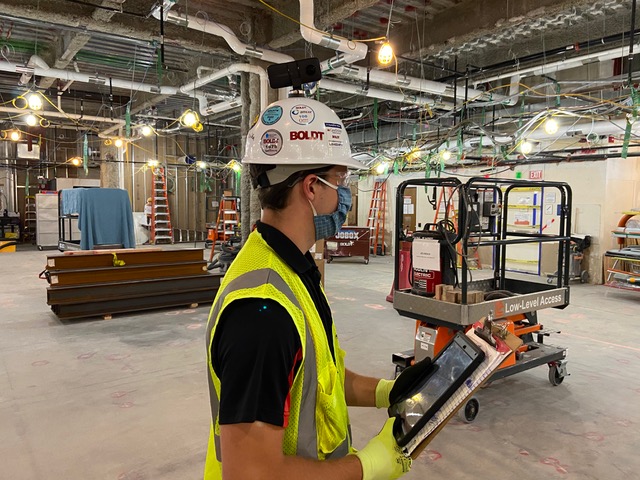
When physical distancing puts a wrench in the personalized give and take of building complicated structures, adaptation is key. Reopening plans for The Boldt Company’s 14 national offices and dozens of jobsites depended on innovation and a creative use of technology.
The company created a task force to address facilities and technology, then tapped experts in its own technical services division to pull together a center of excellence to address reopening. The task force identified issues for operations, safety, technology, different geographic markets and assigned a leader for each topic. Team members identified issues such as split work schedules, team members who would continue to work from home, different state requirements and even the mood of their teams.
Technology quickly led the way to address safety issues and physical distancing guidelines.
“The pandemic has been a catalyst for forcing change via technology,” said Dave Much, Boldt’s director of emerging technologies. “Because we’re using Microsoft Teams, it was seamless for most of our workforce to go home and not worry about connecting to work.” According to Much, in the last 90 days Boldt employees nationwide engaged in:
- 335,224 chat messages
- 15,517 video or telephone meetings
- 17,197 participants in those meetings
And on construction jobsites, there were even more unique challenges.
In most states, construction was declared an essential industry, so early in the pandemic the contractor created a health screening system for anyone entering a jobsite or office. Workers, subcontractors and even customers were required to fill out a daily health assessment form and have their temperature screened. But the individual pieces of paper started piling up and the number of subcontractors on multiple jobsites added to the paper.
For Dan Wagner, a Boldt superintendent in California, he was juggling 150 pieces of paper a day and trying to do it while working remotely. “A paper form requires someone to touch it, put it in a bin and keep as a record,” Wagner said. “The very nature of the process was counter to achieving a seamless process that doesn’t spread the virus.”
That’s when Wagner got on a videoconference and asked if the Boldt IT group could design a process based on smartphones. Using Microsoft Forms, the contractor’s IT department created a process in which anyone entering a jobsite scans a QR code and is immediately taken to an online survey for health assessment. If an individual’s answers raise a potential COVID-19 concern, the screen indicates the user is denied jobsite access and the survey is immediately referred to the superintendent and safety personnel.
“The system notifies us in seconds,” Wagner said. “It makes our safety managers’ lives so much easier because they can manage information and get the reports while working remotely.” He added that most people who don’t pass the assessment do so because they made a data entry error.
When Wisconsin issued safe-at-home orders in March, one of the most complicated jobsites was impacted. The contractor is constructing a six-story, 237,000-square-foot addition to house specialty clinics and surgical services at Children’s Wisconsin. Work was in progress for wall framing and in-wall rough-in for the finishing stage of construction and on any given day there were about 225 people on the jobsite. As an essential industry, construction crews stayed on the site, but support services, construction management and facilities executives from Children’s were working from home.
“Our architects in Chicago weren’t coming up, and much of our project team was working remotely,” said Scot Lauwasser, Boldt project manager. “We started tying up our resources with video conferences and having a hard time sending site photos to all parties.”
That’s when he remembered a 360-degree camera mounted on a hard hat that takes photos every ½ second as a person walks through a construction site. “It’s sort of like Google street view for construction projects,” Lauwasser said. The photos are automatically uploaded to a website and map directly onto site plans, floor plan layouts, even computerized BIM models of the building. Photos and floor plans are accessible by anyone with an internet connection.
“We walk the jobsite once or twice a week,” Lauwasser said. “Customers and construction partners can log in at any time and immediately see the progress of the job based on the timeline.”
In planning to reopen offices nationwide, the core planning team again looked to technology to provide accurate health screenings and do so quickly and accurately. Much suggested going one step beyond thermal temperature cameras and is looking at a system that provides temperature checks, uses facial recognition and can be linked into each building’s security system. Team members who pass the temperature scan can be automatically admitted into the building in one scan.
“Hand-held thermometers aren’t always accurate, and they require a person be within 6 feet of the individual,” Much said. “We were looking for a solution that provided quality data.” The system is currently being tested at the firm’s headquarters in Appleton, Wisconsin.
For more information, visit www.boldt.com.



 Join our thriving community of 70,000+ superintendents and trade professionals on LinkedIn!
Join our thriving community of 70,000+ superintendents and trade professionals on LinkedIn! Search our job board for your next opportunity, or post an opening within your company.
Search our job board for your next opportunity, or post an opening within your company. Subscribe to our monthly
Construction Superintendent eNewsletter and stay current.
Subscribe to our monthly
Construction Superintendent eNewsletter and stay current.